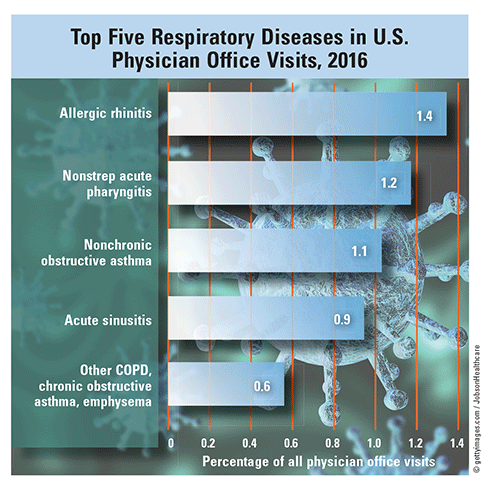US Pharm. 2020;46(7/8):14.
The National Center for Health Statistics notes that the prevalence of physician ambulatory-care visits for respiratory diseases is highest in persons aged >85 years and is 57% and 85% lower in those aged 75 to 84 years and 65 to 74 years, respectively. Respiratory-disease mortality rates across these age groups were within 15% of each other.

Ambulatory-Care Visits: Of the 85.2 million physician ambulatory-care visits with respiratory disease as the primary diagnosis, the top four disorders were allergic rhinitis (19.4%), nonstreptococcal acute pharyngitis (16.7%), nonchronic obstructive asthma (15.2%), and acute sinusitis (12.5%). Other respiratory disorders included chronic obstructive pulmonary disease (COPD) and chronic obstructive asthma. A small number of ambulatory-care visits had a primary diagnosis of malignant neoplasm of the trachea, bronchus, or lung.
Drugs: Of the majority of therapeutic categories of drugs prescribed during physician ambulatory-care visits (topical agents, hormones, central nervous system agents, cardiovascular agents, and anti-infectives), respiratory agents constituted 40.2% of prescriptions. The bronchodilator category comprised adrenergic bronchodilators (18.2% of these prescriptions), bronchodilator combinations (5.2%), anticholinergic bronchodilators (1.2%), and methylxanthines (0.3%). The three types of generic agents that constituted one-fourth of the 20 most frequently prescribed medications at the first ambulatory-care visit for asthma were adrenergic bronchodilators (16.9%), leukotriene modifiers (4.7%), and nasal steroids (4.2%).
Chronic Lower Respiratory Disease (CLRD): CLRD includes COPD, asthma, and some other lung diseases. Eighty percent of COPD cases are caused by exposure to cigarette smoke; genetics and environmental workplace conditions have been identified as other contributing factors. The prevalence of COPD decreased from 7.2% for 2008–2009 to 6.4% for 2014–2015. Marginally more males than females at ambulatory-care visits presented with COPD (3.7% vs. 3.5%), and the prevalence of COPD at these visits increased with age, from 0.5% in those aged >45 years to 8.8% in those aged 75 years and older. CLRD has resulted in 49.2 deaths per 100,000 adults, making it the fourth leading cause of death. Mortality rates per 100,000 were 0.2, 2.2, and 45.8, respectively, for bronchitis, emphysema, and other nonasthma CLRD. The mortality rate for CLRD in women (45/100,000) was 10% higher than in men (40.9), ranking third and fourth, respectively, in leading causes of death. Although the mortality rate for COPD declined in men from 1999 to 2014 (from 57.0/100,000 to 44.3/100,000), it did not change significantly in women (from 35.3/100,000 to 35.6/100,000).
The content contained in this article is for informational purposes only. The content is not intended to be a substitute for professional advice. Reliance on any information provided in this article is solely at your own risk.
To comment on this article, contact rdavidson@uspharmacist.com.






